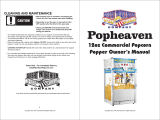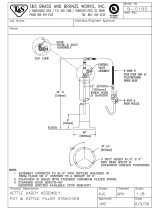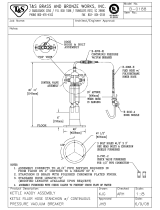
INSTALLATION, OPERATING,
SERVICE AND PARTS MANUAL FOR
DIRECT STEAM TWO-LEG
COUNTER MOUNTED TILTING
2/3 JACKETED KETTLES
SERIES: VDC
Vulcan service agencies are located throughout the
United States. For location and phone number of one
near you, call your local Vulcan dealer.
VULCAN-HART COMPANY, P.O. BOX 696, LOUISVILLE, KY 40201-0696, TEL. (502) 778-2791
FORM 30006 (2-90)

IMPORTANT
OPERATING, INSTALLING AND SERVICE PERSONNEL
The operating information on this equipment has been prepared for use by qualified and/or authorized operating
personnel.
All installation and service on this equipment is to be performed by qualified, certified, licensed and/ or
authorized installation or service personnel, with the exception of any part marked with a in front of the part
number.
To obtain the name and location of an authorized Vulcan service agency, contact your Food Service Equipment
dealer or Vulcan-Hart Company at the address or phone number shown on the front cover of this manual.
DEFINITIONS
QUALIFIED AND/OR AUTHORIZED OPERATING PERSONNEL
Qualified or authorized operating personnel are those who have carefully read the information in this
manual and are familiar with the equipment's functions or have had previous experience with the
operation of the equipment covered in this manual.
1. For the installation of gas piping from the outlet side of the gas meter, or the service regulator
when the meter is not provided, and the connection and installation of the gas appliance, qualified
installation personnel must be experienced in such work, be familiar with all precautions required,
and have complied with all requirements of state or local authorities having jurisdiction. In the
absence of local codes, installation must comply with National Fuel Gas Code ANSI Z223.1 latest
edition.
2. For the installation of electrical wiring from the electric meter, main control box or service outlet to
the electric appliance, qualified installation personnel must be experienced in such work, be
familiar with all precautions required, and have complied with all requirements of state or local
authorities having jurisdiction. In the absence of local codes, installation must comply with the
National Electrical Code ANSI NFPA No. 70 latest edition.
3. For the installation of steam piping from the source of supply to the service inlet of the appliance,
qualified installation personnel must be experienced in such work, be familiar with all precautions
required, and have complied with all requirements of state or local authorities having jurisdiction.
QUALIFIED SERVICE PERSONNEL
Qualified service personnel are those who are familiar with this equipment who have been endorsed
by our company. All authorized service personnel are required to be equipped with a complete set of
service and parts manuals and stock a minimum amount of parts for this equipment.
SHIPPING DAMAGE CLAIM PROCEDURE
For your protection, please note that equipment in this shipment was carefully inspected and packed
by skilled personnel before leaving the factory. The transportation company assumes full responsi-
bility for safe delivery upon acceptance of this shipment.
If shipment arrives damaged:
1. VISIBLE LOSS OR DAMAGE - Be certain this is noted on freight bill or express receipt and
signed by person making delivery.
2. FILE CLAIM FOR DAMAGES IMMEDIATELY - Regardless of extent of damage.
3. CONCEALED LOSS OR DAMAGE- If damage is unnoticed until merchandise is unpacked, notify
transportation company or carrier immediately, and file "concealed damage" claim with them.
This must be done within fifteen (15) days of the date the delivery is made to you. Be sure to
retain container for inspection.
We cannot assume responsibility for damage of loss incurred in transit. We will, however, be glad to
furnish you with necessary documents to support your claim.
PLEASE RETAIN THIS MANUAL FOR FUTURE REFERENCE
2

INDEX
Your Vulcan Steam Jacketed Kettle is produced with
quality workmanship and material. Proper installation,
usage and maintenance will result in many years of
satisfactory performance.
The manufacturer suggests that you thoroughly read
this entire manual and carefully follow all of the instruc-
tions provided. Keep this manual for future reference.
A data plate with the unit model number, serial
number, and direct steam supply that the unit can use
is on the kettle.
DESCRIPTION PAGE
DEFINITIONS OF OPERATING, INSTALLATION and SERVICE PERSONNEL AND SHIPPING
DAMAGE CLAIM PROCEDURES (Inside Front Cover)
INDEX 3
DESCRIPTION 4
CAPACITIES 4
INSTALLATION 5
CLEANING 5
OPERATING 6
TROUBLESHOOTING 6
PARTS LIST: TILTING HANDLE 7
3

DESCRIPTION
The Vulcan tilting direct steam kettles in this manual
are pressure vessels with double wall stainless steel
construction forming a sealed jacket around the lower
two thirds of the kettle bowl surface.
The kettle bowl is the container for the food product
which should be a liquid or semi-liquid for complete
contact with the bowl surface, to fully absorb the heat
transmitted through the surface from the steam in the
kettle jacket. Entrance of steam into the jacket is
controlled by a manual control valve in the right leg.
The kettle is tilted by a removable operating handle on
the right side. (Can be mounted on either side.)
These tilting kettles are to be permanently mounted on
a counter top on its two legs. The kettle rests on a
single rear support leg that has a flush inserted nylon
foot.
Each kettle is equipped with a relief valve. Options
include a lift off stainless steel lid covering the kettle
bowl opening, and a pour strainer.
CAPACITIES
Models end with 6 or 10 which indicate the capacity of
each kettle in gallons. Model VDC6 has a capacity of 6
gallons, the VDC10, 10 gallons.
4

INSTALLATION
WARNING: PLUMBING CONNECTIONS MUST
COMPLY WITH APPLICABLE HEALTH,
SAFETY AND PLUMBING CODES.
A. These kettles must be installed on a suitable table
or counter top.
B. On counter top provide 7/8" holes on 13 3/4"
centers for the two kettle leg stanchions. Provide
sufficient space from the rear wall to allow the
kettle to freely tilt.
C. Remove the mounting locknuts and washers from
the bottom of the legs. Apply a high grade sealing
compound to the flared edge of the stanchions.
Insert the threaded portion of the stanchions
through the holes. Replace washers and lock nuts
and tighten. Wipe off excess sealant.
D. The relief valve on the kettle must not be adjusted
or closed off as it is set to relieve excess pressure
in the kettle.
E. Connect the steam supply line (1/2" pipe size) to
the steam inlet fitting on the right leg.
F. Install a separately purchased steam control valve
in the steam supply line, preferably near the kettle
for ease of operation.
G. A separately supplied pressure reducing valve will
be required if the steam supply pressure is greater
than the maximum kettle working pressure.
H. If large amounts of water are in the incoming
steam line, it will be necessary to buy and install
one or more ball float traps in the line to eliminate
the water. Trap is to be mounted in a drip leg on
the supply line (not directly in the supply line).
I. A separately purchased steam line pressure
gauge is also recommended to determine the
actual amount of steam coming to the kettle.
J. Install a suitable steam trap (not supplied) in the
condensate line (left stanchion) near the kettle
and run a condensate return line to the drain. If
the condensate line will be going to the boiler,
then it must have a check valve and a gate shut
off valve (neither supplied) near the kettle.
K. Check for proper operation.
CLEANING
The kettle interior and exterior should be thoroughly
washed after each use when a different food is to be
cooked next or when cooking is completed for the day.
Before cleaning, check that the kettle has cooled
enough to touch it.
A. Check that the steam supply is turned OFF.
B. Rinse the inside of the kettle thoroughly and tilt it
to remove any food particles.
C. Using a nylon brush, clean the kettle with a mild
detergent and warm water rinse. Never use steel
wool or scouring powder as it will scratch stainless
steel. Also, steel wool can leave small pieces of
steel which can rust.
D. Tilt the kettle fully to allow the detergent and water
solution to drain. Rinse thoroughly with clean
water.
For reduced cooking time the air should be exhausted
from the jacket by opening the separately purchased
relief valve until the air has been complete replaced by
pressurized steam.
In the initial stages of the cooking process, when the
steam comes in contact with the cold kettle bowl
surface it condenses and forms considerable amounts
of water. A separately purchased thermostatic steam
trap should be installed at the exit end of the kettle
jacket. This trap is a mechanical device that closes on
high temperatures and opens when the temperature
drops, allowing the water formed from the condensate
to exhaust but retain the steam under pressure.
5

OPERATING
A. Fill kettle with product to the desired level.
NOTE: Food products with milk or egg base should be
placed into a cold kettle and then the cooking
operation begun. Avoid sudden contact of
these food products with a hot kettle surface
because the food will stick to the surface.
B. Slowly turn the steam control valve "ON" to the full
open position.
C. Slowly open the relief valve to allow all air to
escape. Stay clear of the valve outlet during this
operation to avoid very hot steam.
D. The water or food should boil in 3 to 4 minutes per
gallon. If it does not, then incoming pressure
should be checked to determine that it is
adequate to operate the kettle efficiently.
E. Regulate the steam control valve depending on
the type of food being prepared.
F. When the food is cooked, turn off the steam,
remove the food, add water and clean the kettle
immediately to prevent residue from drying on the
kettle bowl.
WARNING: THE KETTLE IS HOT. USE CARE WHEN
OPERATING AND SERVICING THE KETTLE.
TROUBLESHOOTING
EXTREMELY SLOW COOKING TIME
If the cooking time is abnormally slow, then the difficulty
may be due to insufficient steam pressure and/or vol-
ume. First determine that the pressure on the incoming
steam line is within 5 p.s.i. of the rated kettle pressure.
Note that pressures approaching the rated kettle pres-
sure are liable to set off the relief valve. If the required
pressure is available at the kettle, then possibly the
volume of steam is not sufficient. Minimum 3/4" pipe size
is required to the kettle but if the steam generating
source is at a great distance from the kettle, larger pipe
will be required. Finally, the core of the steam supply
pipe may have debris or scalants that impede steam flow
and the pipe will require disassembly and inspection.
6

PARTS LIST: TILTING HANDLE
ITEM NO.
PART NO
NO.
DESCRIPTION QUANTITY
VDC6 VDC10
1 NS-025-16 NS-025-16 Acorn Nut 1
2 836935 836935 Handle 1
3 836964 836964 Knob 1
4 836996 836996 Cap 2
5 836972 836998 Stanchion Assembly 2
6 WS-030-36 WS-030-36 Washer 2
7 FP-030-30 FP-030-30 Locknut 2
8 881966 881966 "0" Rings (Not Shown) 4
9 881982 881982 Retaining Ring (Not Shown) 2
7
-
 1
1
-
 2
2
-
 3
3
-
 4
4
-
 5
5
-
 6
6
-
 7
7
Vulcan Hart VDC6 User manual
- Type
- User manual
- This manual is also suitable for
Ask a question and I''ll find the answer in the document
Finding information in a document is now easier with AI
Related papers
-
Vulcan Hart VDWS-40 User manual
-
Vulcan Hart VELT60 User manual
-
Vulcan Hart VDC10 Datasheet
-
Vulcan Hart VDL20 User manual
-
Vulcan Hart VEP20 User manual
-
Vulcan Hart VDL20 User manual
-
Vulcan Hart VDLT User manual
-
Vulcan-Hart 2T2036E Specification
-
Vulcan-Hart VDPT40 User manual
-
Vulcan Hart VDMT60 User manual
Other documents
-
 Great Northern HWD630159 User guide
Great Northern HWD630159 User guide
-
Crown DC-20 Owner's manual
-
Capkold Steam Jacketed Kettle DH/INA/2-100 User manual
-
 T & S Brass & Bronze Works B-0195 Datasheet
T & S Brass & Bronze Works B-0195 Datasheet
-
 T & S Brass & Bronze Works B-0196 Datasheet
T & S Brass & Bronze Works B-0196 Datasheet
-
 T & S Brass & Bronze Works B-0188 Datasheet
T & S Brass & Bronze Works B-0188 Datasheet
-
Crown DP-60F Owner's manual
-
Crown DP-60F Owner's manual
-
Crown DP-60 Owner's manual
-
Crown DLT-80TC Owner's manual










